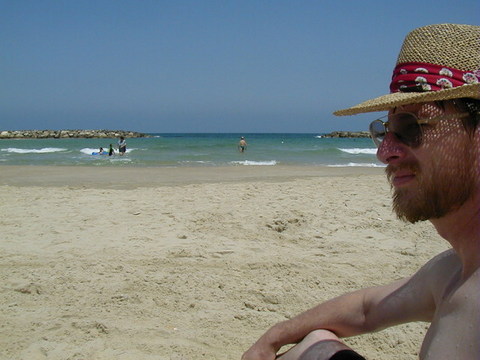Where were we? Oh yes, hanging on a cliff, trying to get a date.
Getting a direct date requires having something made out of carbon-based materials. Pottery isn't carbon-based, nor are any of the metal or stone objects we excavate. However, wood, seeds and pits are, so a burned beam in a destruction layer or wheat that has been charred in some conflagration in the past represents an ideal opportunity for dating.
The method is called 'Carbon 14 Dating', or sometimes just 'Carbon Dating.'
14 doesn't represent the 14th method they tried to use carbon to date things, but the atomic weight of the particular isotope of carbon that is used in the process.
Let me explain. Carbon is an essential part of life on earth: we eat carbohydrates (carbon plus hydrogen), exhale carbon dioxide gas, drive cars powered by hydrocarbon-based fuels. Most of our body consists of a combination of water and carbon-based compounds. In fact, these compounds are so tied to living creatures (organisms) that they are called 'organic compounds.'
Where does this carbon come from? Plants take carbon dioxide from the atmosphere and convert it with the help of energy from the sun to carbohydrates in a process called photosynthesis. Animals then eat the plants or other animals that have eaten plants, and the carbohydrates become a part of them. When they die, they are slowly decomposed back into more simple compounds, ultimately to carbon dioxide or solid carbon in the form of charcoal.
So far, so good? OK, now here's the deal. "Carbon" isn't just this pure element, at least as it's found in nature. "Carbon" is a mixture of 3 things - Carbon 12, 13 and 14 (denoted C12, C13, C14). These are called 'isotopes' of Carbon. They have the same number of protons as every carbon has (6), but have either 6, 7, or 8 neutrons, making them weigh 12, 13 or 14 atomic mass units.
As it turns out, there is 98.89% C12, 1.11% C13 and 0.00000000001% C14 in the carbon dioxide in the atmosphere. How did the C14 get there? It was created high in the stratosphere, where high energy Beta particles slam into Nitrogen (which normally has 8 neutrons and 7 protons), stripping away one proton, leaving 6 protons and 8 neutrons, which, as we noted above, is C14.
C14 is not a stable isotope: that is, it will slowly turn itself back into Nitrogen by emitting a beta particle and gaining a proton. Think of it as the reverse of how C14 was created. We call this a 'radioactive' isotope, and those Geiger counters that we see in old movies looking for radioactivity are measuring the emitted beta particles.
Each gram of naturally occurring carbon (say from a recently charred charcoal briquette) emits 15 beta particles per minute. Over time the number of particle emissions falls, and every 5730 years (plus or minus 40 years), there are half the number of beta emissions per gram- 7.5/min for something 5730 years old, 3.75/min for 11460 years old, and so on. By about 50,000 years, the count rate is so low that it's indistinguishable from the background noise of random beta particles.
Another way to measure C14 is by putting it in a mass spectrometer. This is a device which strips away an electron from carbon in the sample, then accelerates it electromagnetically through a large magnet and toward a series of detectors. Because of inertia, the isotopes that are 'heavier' aren't turned off course as much by the magnet, so a detector at the spot where C14 curves, and another detector at the spot where C12 curves can count the number of atoms at each spot. This gives a direct measurement of the ratio between C12 and C14. This is a much more sensitive test, and allows C14 to be used to date back to 100,000 years ago, with as little as 1 milligram sample size.
"But," the observant reader asks, "doesn't this assume that the rate of decay and the ratios of C14 to C12 in the atmosphere remain constant? What about variation in cosmic ray activity?"
I'm so glad you asked! We happen to have a handy calibration device available. It's called "Tree Rings!" The carbon in the inside of trees can be analyzed for C14, and shows the general trend you would expect for C14 decay, with some variation. Analysis of multiple trees has given a correction factor for each year back to about 10,000 years ago, or the beginning of the Neolithic period. (No, we don't 10,000 year old trees we cut down to do this - talk about old-growth forests! - it's done by analyzing older and older wood that has overlaps in the ring patterns of wet year, dry year that act like a fingerprint for each tree.)
Note that this depends on good collection of samples: one cough or the oil from fingers from an incompetent excavator may throw off the analysis by centuries.
For the Iron Age (1200-586 BC, about 3000 years ago), the accuracy is about an 80 year range, when corrected.
All told, although the C14 dating gives ballpark numbers, it comes at a fairly significant cost, and with such a wide date range, it is not used often for dating the layers. Ceramics analysis remains the tool of choice for that task.
